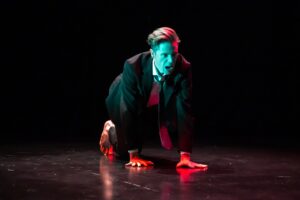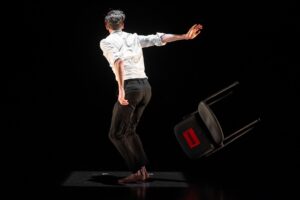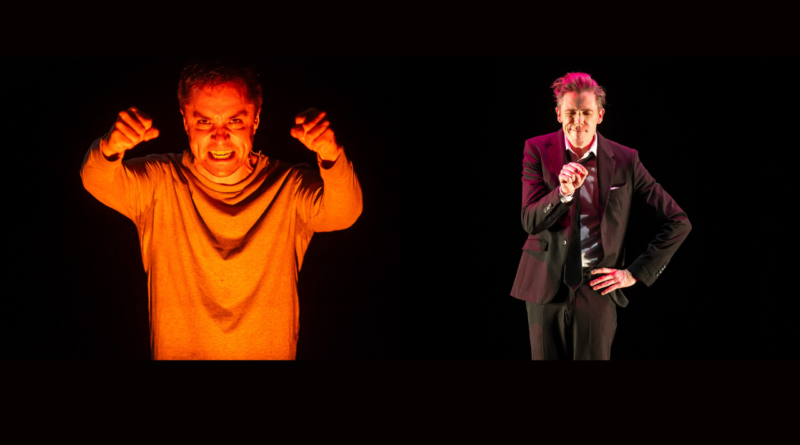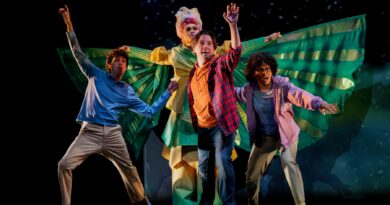Psychotic jack-in-the-box or liar’s roller coaster: choose your own Factory Theatre thrill ride this holiday season

This . . . this is why we go to the theatre.
We go to the theatre to be transported. To be amused, challenged, and even confronted. But above all, to immerse ourselves in something other than our own lives for a short period of time. To have an experience.
And after immersing ourselves in that experience – no matter how good it was – we promptly forget most of it. We retain the broad strokes of the plot, a memorable moment or two, and a sense of what the show means. We have impressions of noteworthy performances and a judgment of the show’s quality. But the vast majority of the experience? All the specific details that the writer, actors, set designer, director have sweat over? They’re just gone.
Two solo shows currently on-stage at Factory Theatre – Monster and Here Lies Henry by playwright Daniel MacIvor – lean into this fact – hard.
MacIvor, of course, is a master of the solo show, and these two are not new. Working with his frequent collaborator director-playwright Daniel Brooks, he wrote Monster in 1998 and Here Lies Henry even further back, in 1995. For the Factory productions, he has updated the scripts. They deliver a base layer that is fresh, disturbing, and emphatically now.
Both shows focus our attention on a single actor translating the impossibly dense demands of MacIvor’s scripts into jaw-dropping experiences that are more than the sum of the words and ideas . . . and whose brilliance is palpable and transcendent, but then is just . . . gone.
Monster
Monster starts and ends in silence and darkness that lasts just a bit too long. Then we discover we’re in a movie theatre, and someone is shushing a fellow audience member. Suddenly, the light comes up, and actor Karl Ang disappears inside the first of some sixteen characters he will play. They are all victims or perpetrators of trauma (some are both), and their traumas all somehow intersect the story of a boy who dismembered his father in a basement.

We’re not sure what is true, or how exactly these stories fit together . . . but Ang is mesmerizing as he weaves this complex web. Like a homicidal jack-in-the-box, he stands with his feet pinned to a spot that feels just a little too close for comfort to the front of the stage. There, he sways, gestures, and talks, talks, talks. Then, in a split-second of blackness, Ang invisibly adjusts his posture and height – all without moving those feet – and, bathed in new lighting and using a new voice, he has become a new character telling their story or even a couple having an argument.
Throughout the show, which is directed with unrelenting intensity by Soheil Parsa, we half-fear that this snarling, cyclonic menace will rip one unseen foot from the stage, then the next, and lumber destructively down into the audience. Instead, you are pelted by an unrelenting torrent of the quotidian, the grotesque, the absurd and the offensive – wrapped in different stores, delivered in different voices by characters with different attitudes and ages.
Ang’s acting – especially given the physical demands of the performance – is a tour de force. We’re witness to an intense act of theatrical geology. These different people – whose stories intersect through generational relationships, neighbourhood proximity, chance encounters, and fictional vehicles – are accretive, piling one on the next.
Are monsters born? Or are they inevitable creations of psycho-geological compression? And how should we view them: with horror and fear? What about pity? Or even just . . . equanimity?
All we can do is sit in that torrent of recounted experience, observation and insight. In its dense and tightening vice-grip, we can begin to intuit how – not just one “Monster”, but many monsters – can be formed. We can begin connecting the tantalizing threads. We can laugh at the funny moments (there are far more than you would expect). We can marvel, wonder and recoil.
And we can forget all of it almost immediately because if we stop, we’ll miss something. And once it’s over, the silence of the real world is almost deafening.
Here Lies Henry
Think of Here Lies Henry as an inversion of Monster.

Actor Damien Atkins plays just one character: the titular Henry. After shuffling tentatively onto the stage, Henry seems compelled to try to connect with us as an audience. He does this by recounting and interpreting elements of his life story – with special focus on the tiny details, where (it seems) meaning resides.
But because Henry is twitchy and slippery, this proceeds in no straighter a line than Monster did. Henry tells us early on that he is a liar, and he revels in providing us periodic proof. What he delivers is a succession of theatrically acrobatic and recursive micro-performances, laced with personal reminiscences, verbal tics and cynical diatribes. Atkins is playing just one character. But that character is so captivating in his mile-a-minute mercuriality – tentative and wistful; then boastful, brash and defiant; then ranting and spluttering; then musing reflectively – that Henry both daunts and delights us.
Under Tawiah M’Carthy’s skilled direction, the theatre becomes the geography of the soul – or at least the human-built structures erected atop the soul. For a brief time after he enters, Atkins is moored to a centre-stage spot just like Ang in Monster. But soon enough, he begins to move: to shuffle to the side, to dance to the left and to the right, and eventually, to descend right off the stage into the audience. Those wanderings unsettle us. They unbalance our understanding of what is really happening, which will not be fully cemented until he tells us his final lie.
As with Monster, there’s a mystery here. Henry knows that he is performing. At times, he is pinned by lighting that unsettles him. At other moments, he summons music and sound, changing the mood at will. He even comments on the tape marks on the stage that show him where he needs to stand. And the performance mystery involves us as audience members. Where are we supposed to be? Who are we? And why are we essential to this construct?
For essential we are. The quicksilver Henry is going to reach out directly to us. He will make eye contact. He will tell us – individually – that he sees us. He will make requests of us. Try not to fall under his tortured, guilty, passionate spell. Try not to be cut to the quick by his cynical, too-close-for-comfort insights on relationships. And try not to surrender when he tells you who you are and what you like. (Atkins-as-Henry pinned me in his gaze and told me that I like going to the movies. I couldn’t help myself: I smiled and nodded my agreement.)
M’Carthy and Atkins have us on a roller coaster. Henry wants to win us over: to show us he understands us, and to tell us something that we don’t already know. But the coaster is moving quickly. We can’t possibly reconcile or even understand all the details. All we can do is hang on, white-knuckled, as roiling insecurities and shards of truth fray the proffered skein of ego.
Afterwards

When each of these very different shows concludes, we find ourselves out of breath after a thrill-a-minute experience. We now know how the ride works. We understand its premise, and we can describe it in basic terms. But the details – so dense, so variegated, and so relentless – are a complete blur.
Ang and Atkins have delivered one hell (actually two hells) of a good, immersive experience – the kind of transcendent experience that defines why we go to the theatre.
Only one course of action makes sense. Like dizzy kids stumbling away from Space Mountain at Disney World on a slow day, let’s run back to the entryway. . . and do it all over again.
Reserve tickets to Monster and Here Lies Henry, now on stage at Factory Theatre.
© Scott Sneddon, Sesayarts Magazine, 2023
About The Author
Scott Sneddon
Scott Sneddon is Senior Editor on SesayArts Magazine, where he is also a critic and contributor.
Visit About Us > Meet the Team to read Scott’s full bio …




